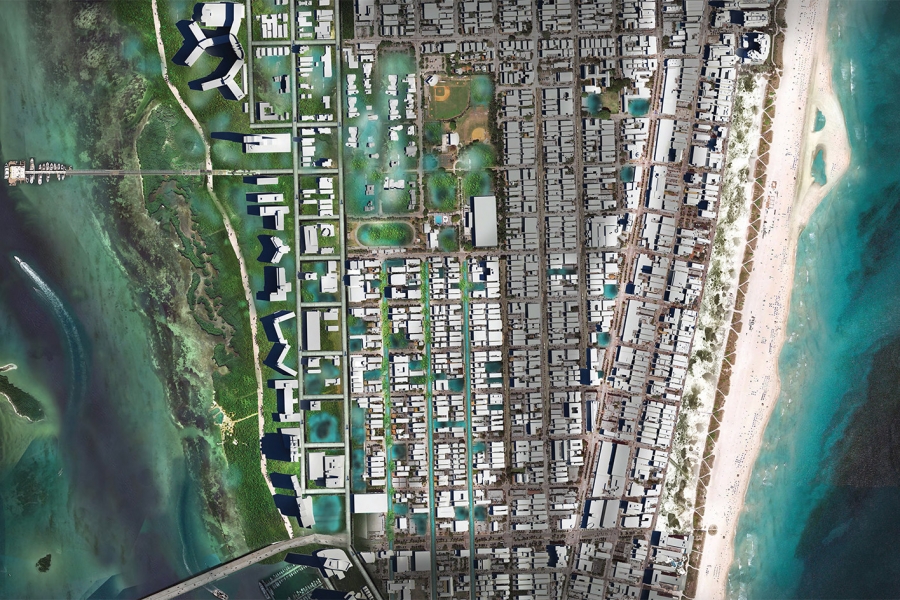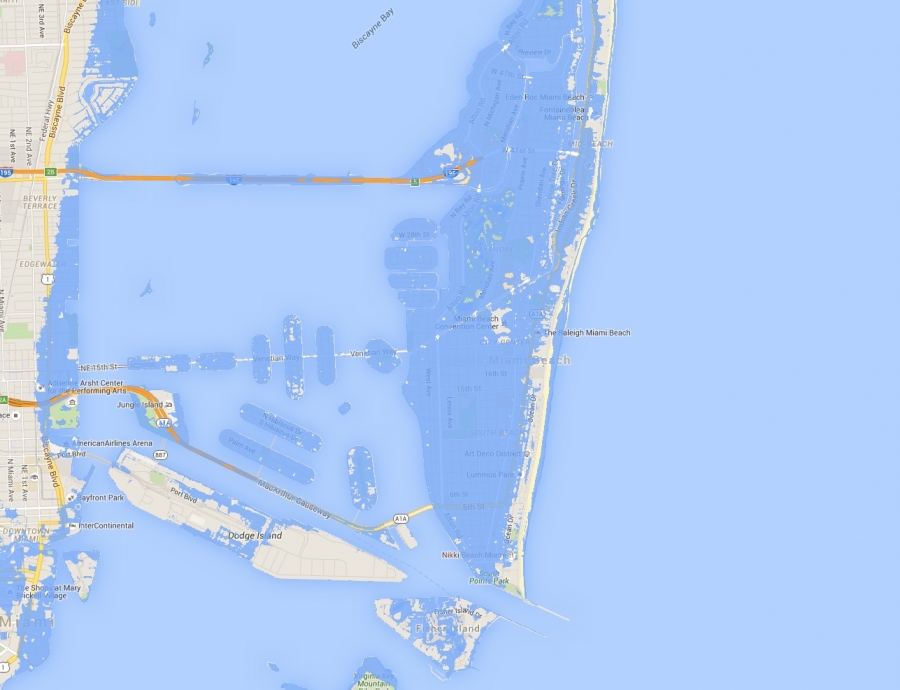Miami and Miami Beach are chief among coastal cities around the world threatened by sea level rise and its by-now-certain financial and real estate costs. Considering the worldwide implications, all eyes are now on Miami and Miami Beach and their decided courses of action. As stated by Thomas J. LeBlanc, Executive Vice President and Provost of the University of Miami, “we think of Miami as ground zero on climate change. Miami, in some ways, is a model for every coastal city.”
At this point, scientists are generally in agreement that sea levels are rising, but how high and how quickly are the real questions. Recently, on Tom Ashbrook’s show, On Point, Ben Kirtman — a professor at the University of Miami’s Department of Atmospheric Sciences — claimed that the predicted estimates vary between 8 to 24 inches in the next 30 years. Harold Wanless, an expert on sea level rise from the University of Miami who is notoriously pessimistic about South Florida’s future, speculated in a recent Vanity Fair article entitled ‘Waterworld’ that sea levels could rise over 10 feet by 2100, which would cause dire, unfathomable consequences.
According to the World Resources Institute, the two main sources of sea level rise are freshwater input from melting glaciers, ice caps and sheets, and the warming oceans. NASA reports that global sea levels have increased over 6.5 inches in the past century, yet the rate of increase has nearly doubled in the last decade; thus, making it difficult to predict the future of our tides.
South Florida is especially vulnerable as a result of four major factors: the region is flood-prone, hurricane-prone, water-bordered, and uniquely sits atop porous limestone (the “swiss cheese” of rocks as described by Glenn Landers, a Professional Engineer with the U.S. Army Corps of Engineers), making the challenge of building for resiliency immense since relatively small sea level increases would still require costly improvements (think more flooding and saltwater intrusion to our drinking water). With Miami regarded as the city with the fourth-largest population vulnerable to sea level rise and the “largest amount of exposed assets” by the World Resources Institute, many would agree it is imperative to plan ahead.
“We think of Miami as ground zero on climate change. Miami, in some ways, is a model for every coastal city.”-Thomas J. LeBlanc
Amidst the concern of rising waters in South Florida is a major real estate boom featuring renowned-architects, sky-high prices, and billions of dollars pouring in, presenting a fundamental paradox. As the recent Vanity Fair article points out, either buyers might not consider these hefty investments as long-term, or their confidence lies in their faith in science and our elected officials. If predictions are remotely accurate, then real estate prices will plunge and all of these investments become duds, not to mention the estimated hikes in flood insurance. At the same time, this real estate boom is helping to boost the City’s tax base, which can in turn mitigate costs to re-engineer its infrastructure.
When Mayor Philip Levine was elected, he pledged to implement solutions for sea level rise. The citywide plan, which includes elevating roads that are below 2.7 feet above sea level, installing 80 pump stations to drain water back out into Biscayne Bay, and raising sea walls, will reportedly cost up to $500 million to stave off the damage of approximately $23 billion of real estate. Even if the pumps are effective, however, the environmental impact is unknown. As the Herald reported, “FIU hydrologist Henry Briceno sent a team to sample water in Biscayne Bay to see whether the mass flushing had any effect. Sample revealed a sixfold increase in pollution in some parts of the bay.”
The solution, albeit knowingly temporary as a way to “buy” time in the hopes of technological advances, is taking shape in Sunset Harbour where the first phase is underway (a controversial issue in itself because Levine owns properties in the area). Prior to construction, the streets notoriously flooded to the point that water would seep into the neighborhood’s storefronts. The city considered the neighborhood’s streets in a state of emergency, which allowed them to circumvent the required public bidding process for the construction’s completion in a timely manner. As the Miami Herald reported, the project began at $2 million in May 2013, and has since reached up to $31 million, which includes extensions to other parts of the city.
Pieces of the neighborhood have been completed, where streets are elevated and stores are sunken. Some streets in the area are currently being torn apart and elevated, while others await construction. The latest test of the elevated streets came during the last king tide, when areas around Miami Beach flooded, and, fortunately, Sunset Harbour remained dry. Passing this trial suggests Miami Beach might be under construction eternally for a long time.
Bruce Mowry, the city engineer for Miami Beach claims “the rising sea levels will continue and street flooding will continue to increase,” reinforcing the need for a comprehensive, innovative solution. This may prove difficult, given that Governor Rick Scott has banned the term “climate change” in his presence (his term of choice? “Nuisance flooding”). Nevertheless, South Florida is banding together in what’s called the Southeast Florida Regional Climate Change Compact (Broward, Miami-Dade, Monroe and Palm Beach Counties). The counties will collaborate in their efforts and strategies to tackle the challenges ahead. Additionally, Miami Beach announced that it will be partnering with Harvard University’s Graduate School of Design, which recently announced the opening of its Office for Urbanization. The school will conduct a two-year study of the potential effects and courses of action for Miami Beach.
Governer Scott’s term of choice: “Nuisance flooding.”
The issue is widely being discussed around the what-ifs and how-tos. The range of scenarios leaves cities guessing how to resolve the matter. Designer Isaac Stein has an adaptive approach mentioned in the Vanity Fair article (the magazine also went into more detail online), replete with Venice-like canals, channels and “washout floors.” A Miami New Times article further delves into Stein’s plan, demonstrating roads to be built upon stilts and reintroducing a mangrove environment, much like what Miami Beach used to be. Stein tells the New Times, “we can either adapt the infrastructure and make space for the water or let it take over.”

During Ashbrook’s On Point show, architect Allan Shulman proposed a similar, Venice-like solution to Stein’s. He suggests a shift towards “living with the water,” utilizing “waterways,” and using parks as “wetland terraces,” or holding beds for water. Shulman goes on to comment that many historically-significant buildings are incapable of being raised, hence why he recommends it may be best to work with the water.
It should be noted that this idea of a “new Venice” is not a new concept for Miami Beach. In the late 70’s, before sea level rise was a thing, developer Stephen Muss hired architect Steven Siskind in an effort to revitalize the then-dilapidated South of Fifth neighborhood (considered as “one of the worst slums in America”). Siskind devised a prescient plan to transform the neighborhood into a “water community” with small islands built around man-made canals. The proposal was ridiculed at the time, but as it turns out, it might be close to our future solution.
Miami Beach is known as a constantly-evolving city and Mayor Levine is hopeful that examples of 21st century innovation can allow for Miami Beach’s survival. Time will tell. In the meantime, what do you say, once a swamp, always a swamp? Are you packing your bags or are you sitting tight?



